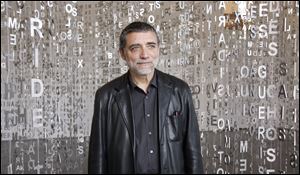
Superstar sculptor Jaume Plensa to give a talk at the art museum
3/13/2013
Sculptor Jaume Plensa will give a free talk and slide show at 6 p.m. Thursday in the Peristyle at the Toledo Museum of Art
The body’s what we know best.
“It’s the only thing we carry with ourselves forever,” says Jaume (pronounced ZHOW-may) Plensa. A superstar among sculptors, Plensa’s works often take the form of bodies or heads.
He’ll give a free talk and slide show at 6 p.m. Thursday in the Peristyle at the Toledo Museum of Art, focusing on his work in public places, from Sweden to Dubai, Singapore to Brazil.
Spiegel, the German word for glass or mirror, was installed in November on the museum grounds near the corner of Monroe Street and Collingwood Boulevard.
“The pieces fit so well in that site,” says Barcelona-born Plensa, 57, in an interview with The Blade from Spain. Last summer, he walked the museum’s lawn scouting for the ideal spot to plant Spiegel’s two 12-foot-tall figures that are seated, hugging knees, and facing each other (but lacking faces). They’re a white latticework of steel letters, randomly placed and drawn from eight alphabets. They suggest conversation, and symbolize the body’s cells.
“I consider the human body as a container, not just for anatomic things but for emotions, thoughts, and so on.”
Plensa creates work that people are immediately drawn to, says Amy Gilman, associate museum director and curator of contemporary art. “It also has a depth to it that allows it to resonate with people over time.”
After seeing an outdoor show of his sculptures at the Frederik Meijer Gardens & Sculpture Park in Grand Rapids, Mich., she decided the museum should bring a Plensa into its collection. His work, she adds, “has so quickly has become a beloved part of the outdoor sculpture garden.”
Spiegel was made for a 2011 show in the serene Yorkshire Sculpture Park, which drew record crowds to northern England; it was long-time arts patron, Rita Kern of Perrysburg, who gave the money to buy it.
Plensa still lives in Barcelona where he leads seven technically skilled employees, sometimes more, who execute his designs. Many pieces share Spiegel’s body form, their steel letters bent by a special press machine: some are human sized, some supersized, others melt into rocks or wrap arms and legs around trees.
“I have a great team that knows much better than I how to make them.”
In London, a glass cone imprinted with words, is on the roof of the BBC Broadcasting House, in memory of journalists killed in the line of duty. When the airs news at 10 p.m., a column of light shines 2,952-feet in the sky. Light is a bridge.
“We have the possibility to illuminate life,” he says. On a teak platform in Jerusalem, a thin beam emanates heavenward every Saturday evening, announcing the end of Shabbat.
And he builds huge heads, often of young girls (eyes closed, dreamy expressions) that reside in city parks and in the shallows of the sea. The head is the place of our dreams, and dreaming, he believes, is something we need to do more.
“I just finished a project in Calgary, people can walk inside, it’s a huge head.” The 39-foot-high Wonderland is a bent-wire portrait of a girl, installed in front of a 59-story tower housing energy corporations. A note about Wonderland explains Plensa’s popularity: “A jury chose the Spanish sculptor to complete the project out of 27 applications. Important factors included his recognition of winter’s impact, ability to engage a wide audience, and his past public art installation successes.”
On a hill near Liverpool where the closing of mines devastated both miners and the economy, the locals created a park. Its centerpiece: the 65-foot tall Dream, the head of a girl fashioned of gleaming white dolomite. It was named England’s best sculpture in 2009. Plensa said he tried to extract the soul of the place. “Art has a tremendous capacity to change the world.”
He delights that couples get married at his see-through building at the harbor in Ogijima, a tiny Japanese island. The little structure provides views of the inland sea and the village pressed into a hill. Its graceful oyster-shell curve of a roof is made of white steel letters.
Best-known to Americans is his Crown Fountain in downtown Chicago’s Millenium Park. Opened in July, 2004, the $17 million work is a black granite reflecting pool between two 50-foot glass-brick towers on which appear the faces of 1,000 Chicagoans, filmed over a four-year-period. When warmth arrives in the Windy City, a nozzle located at the pursed mouth of each individual shown on the towers (subjects were told to shape their lips as if to blow out a candle) intermittently spouts water into the pool, as do gargoyles of European fountains. It’s become a beloved public escape from summer’s heat.
“The night before we opened it, I told my staff to take down the fence. And kids came and came, I don’t know from where.” He was thrilled, watching them turn the reflecting pool into a joyful stage as they danced in the spray. It’s drawn crowds in the tradition of a classic European plaza, and boosted civic pride. After all, he says, a city is not just buildings, but people.
“I really love people,” he says.
See his work at jaumeplensa.com and watch an 18-minute talk at tedxsmu.org/talks/jaume-plensa-art-form-tedxsmu-2011.
Note: The Museum Cafe will be open until 6 p.m. Thursday before the talk. Tickets ($20 for nonmembers/$15 for members) for dinner and a beverage, can be purchased at the main information desk. Information: 419-255-7000.
Contact Tahree Lane at tlane@theblade.com or 419-724-6075.